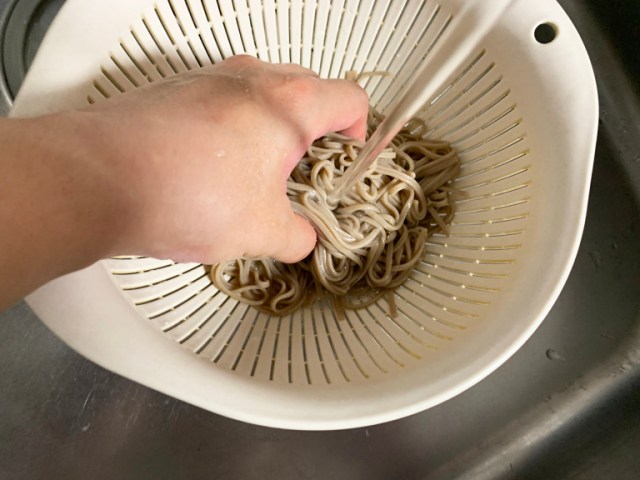
Does Japanese soba go well with yakisoba sauce? Will it hold up in a frying pan? We find out!
If you’ve tried both yakisoba, which are noodles fried in a special sauce with meat and vegetables, and soba, buckwheat noodles usually served either cold with a dipping sauce or in hot broth with various toppings, then you’ll know that the two dishes use very different noodles despite their similar names. You might wonder, then, why do they call it “yakiSOBA”? Perhaps we’ll never know.
What our Japanese-language reporter Seiji Nakazawa wondered is why they don’t use buckwheat soba for yakisoba. After some contemplation, he decided that the only way to know is to try to make buckwheat yakisoba for himself, so he popped into the supermarket and picked up some dry nihachi soba, which is made of two parts wheat flour to eight parts buckwheat flour, to use for his experiment.
Making the yakisoba with soba noodles was a pretty easy process. While boiling the dry soba, he fried up some pork and vegetables, then added the drained noodles in the pan and poured some Worcestershire sauce over it all to give it an element of “yakisoba” flavor. (It should be noted that this isn’t a usual way to dress yakisoba, but Worcestershire sauce is a common ingredient in homemade yakisoba sauce and thus suffices for this experiment.)
Since the cooking went so smoothly, Seiji felt that making yakisoba with real soba didn’t really affect the process of cooking the dish much. He initially thought that the soba noodles would be too fragile to fry, or would stick to the pan, but that wasn’t the case at all.
Here’s the finished product:
Not bad! From initial impression, it smelled mostly of the pork and the sauce. The noodles, stained by the color of the sauce, glistened when picked up with chopsticks. That made him suddenly think that the flavor of Japanese soba might not go well with yakisoba sauce (or in this case, Worcestershire sauce). Maybe that’s the reason why they use Chinese style noodles instead of soba for yakisoba after all…
Well, better try it for himself to make sure!
With the first bite, the salty-sweet taste of the sauce mingled with the flavorful pork in his mouth. The mixture of junk-food flavors reminded him of many hot summer evenings spent at festivals eating yakisoba made by a stall vendor.
But then, quite suddenly, the flavor of the Japanese soba kicked in, and the combination was…
▼ “This…this is…!”
Pretty good!
While having the same tasty flavor of regular yakisoba, this dish also had a flair of sophistication due to its use of the higher quality Japanese soba. To be honest, Seiji couldn’t tell you which one was better! He concluded that the only reasonable thing to do was cook up a batch of regular yakisoba and taste both of them at the same time.
(From here on out, we’ll refer to the ordinary yakisoba as “regular yakisoba”, and yakisoba made with Japanese soba as “buckwheat yakisoba”, just to make the distinction clear.)
▼ Regular yakisoba on the left, buckwheat yakisoba on the right
Compared side by side, Seiji found that the noodles in regular yakisoba were much more slippery. Though he’d never really noticed the texture before, after eating the buckwheat yakisoba he was all too aware of how greasy regular yakisoba really is.
In contrast, the buckwheat yakisoba had a vastly better texture than regular yakisoba. He felt that with even the smallest bite, buckwheat yakisoba had a deeper, more persistent flavor, and felt better on the tongue, too.
After comparing, Seiji was confident in saying that he felt that yakisoba made with Japanese buckwheat soba is much better than regular yakisoba, in both flavor and texture. But if that’s the case, then which is true yakisoba? Is what we’ve been eating all along a mere illusion of yakisoba? Is all of life merely an illusion?
The only way to know is if everyone tries yakisoba made with Japanese soba for themselves. Go forth SoraReaders! Make your own “buckwheat yakisoba” and tell us how you like it. Don’t let Seiji’s existential crisis be in vain!
Photos © SoraNews24
● Want to hear about SoraNews24’s latest articles as soon as they’re published? Follow us on Facebook and Twitter!
[ Read in Japanese ]